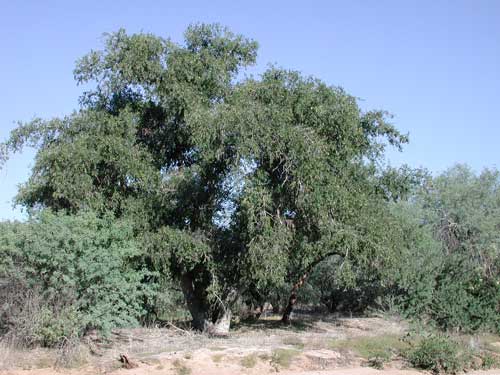Net-leaf Hackberry
Celtis laevigata var.reticulata

A mature tree observed on a wooded terrace adjacent to Mesquite Wash, Maricopa Co., Arizona. The smaller, duller green tree in front at left is a Velvet Mesquite, a frequent associate of Netleaf Hackberry in the Sonoran Desert.

Net-leaf Hackberry makes for an excelent native shade tree in the urban areas of the Sonoran Desert. This specimen is cultivated at the Gilbert Water Ranch, Gilbert, Arizona.
Sponsored Links:
TREE: Usually a small tree, but under favorable conditions can reach
stately proportions supported on a robust trunk. Bark on mature trees is
distintively warted and creased between stretches of smooth gray-brown.
LEAVES: Leaves are elyptic to ovoid, alternate on the stem, with wavy,
entire margins. Veins beneath are prominent as described in the common name.
The texture of mature leaves is tough and gritty.
RANGE: Fairly common above 800 m
elevation, but only along riparian corridors with reliable underground water
supply. Ranges across the western United States and northern Mexico in similar
habitats.
FRUIT: Orange-red berries with one seed mature in fall often drying and
remaining on the tree for months. Relished by many bird species such as
Townsend's Solitaire.
FLOWERS: Green and small, borne in clusters.
UNARMED. No thorns and thus makes an excellent choice for backyard
wildlife habitats.
Ulmaceae -- Elm Family
Sponsored Links:

Net-leaf Hackberry trees almost always harbour a population of gall psyllids (Pachypsylla sp., an aphid-like bug) that reside within the leaf petioles and blisters on the leaf blades. These swollen structures might appear at first to be a fruit of some kind. The bugs produce an irritating substance similar to a plant hormone that causes the petiole to swell providing both room and board for the uninvited guests. The structures become very hard and durable and remain on the tree through the winter providing the psylids a very secure home; the gall somehow prevents the leaf from falling from the tree - ungalled leaves are shed normally. Observed in Rackensack Canyon, Maricopa County, Arizona, 03 Aug. 2008. On 19 Dec. 2008 I observed a Ladder-backed Woodpecker (Picoides scalaris) breaking open a gall after numerous hard pecks and consuming the psyllid contents. Checking the tree I found many galls with holes and chips indicating successfull and unsuccessful predation attempts. The flexibility of the leaf petiole makes the breaking open task difficult; the bird must secure the leaf with one of its toes to get enough leverage.